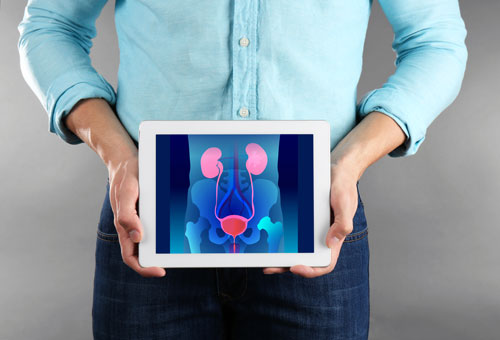The prostate is a small, heart shaped, chestnut sized gland located below the urinary bladder. It surrounds the urethra (tube that carries urine from the bladder out of the body) like a doughnut. The prostate has two major functions: (a) to secrete fluids that make up a portion of the ejaculate volume; and (b) to provide secretions with possible antibacterial effect. A normal prostate gland in an adult male weighs 4-20 grams. People with severely symptomatic BPH can have a prostate as large as 50-80 grams. As the prostate enlarges, it may restrict the flow of urine.

Signs and Symptoms of BPH
All symptoms of BPH can be divided into two categories: obstructive and irritative urinary symptoms.
Obstructive symptoms may include:
- Difficulty starting a urine stream
- Decreased strength of the urine stream, weak flow
- Dribbling after urination
- Feeling the bladder is not completely empty
- Urge to urinate again soon after urinating
- Pain during urination
- Waking up frequently at night to urinate
- Frequent urination
- Sudden, uncontrollable urge to urinate
About 50-80% of men with BPH have an irritative voiding symptom. This usually occurs late in the course of the condition. Irritative symptoms result from a long-standing blockage at the bladder neck. To make up for it, the bladder muscle increases in size so that it can generate a greater force to push urine past the blockage at the bladder opening. Over time, the overstretched muscle is no longer able to hold urine in the bladder. Bedwetting or clothes wetting can occur. People often wake up every 1-2 hours to urinate at night, which causes a poor night’s sleep.
Symptoms, signs, and complications of BPH generally worsen in severity over time, with symptom severity greatest in older men. It is important to treat BPH to avoid complications. It is also important to tell your doctor about all the symptoms that you are experiencing, because some of symptoms can resemble other medical conditions, such as prostate cancer.
Diagnosis of BPH
A physical exam should be done to diagnose BPH. This should include a digital rectal exam, which examines of the prostate, although the size of the prostate gland does not always correspond to the symptoms.
The digital rectal exam will help diagnose BPH. Some doctors will evaluate your described symptoms objectively using the American Urological Association (AUA) Symptom Index. Using this, your doctor will ask you to rate the “bothersomeness” of seven obstructive and irritative voiding symptoms. Your responses to these questions will help the doctor to assess the severity of your BPH.
Other objective measures include:
- Measuring the rate of urine flow out of the bladder (normal is at least 15 mL/sec).
- Measuring how much urine is left in the bladder after you have emptied it. This test is called Postvoid Residual Urine Volume (normal is 0 mL). If more than 25-30 ml of urine is left in the bladder after you have “urinated”, there may be bladder-emptying failure, which may increase your risk for urinary tract infections.
- Prostate specific antigen (PSA) used in combination with a digital rectal exam of the prostate to screen for prostate cancer, which can also cause urinating difficulty. A PSA blood test looks for the presence of a protein that is produced specifically by prostate cells in the blood. The higher levels of this protein may indicate a prostate problem.
Treatment of BPH
Most men with symptoms may not need treatment. They should be managed with “watchful waiting”, which includes return visits to the doctor at 3 to 6 month intervals. If symptoms progress to moderate severity, medicine or surgery may be indicated.
Drug therapy for BPH can be divided into two groups
- Medicines that interfere with testosterone’s stimulation on prostate gland enlargement:
- Proscar® (finasteride)
- Avodart® (dutasteride)
- Medicines that relax the smooth muscle of the prostate:
- Hytrin® (terazosin)
- Cardura® (doxazosin)
- Flomax® (tamsulosin)
- Uroxatral® (alfuzosin)
Another treatment for men with moderate or severe symptoms of BPH or with complications of BPH is surgical removal of the prostate (prostatectomy). Surgical removal of the prostate offers the highest rate of symptom improvement, but also has the highest complication rate. Only you and your doctor can determine the best treatment option for you.

